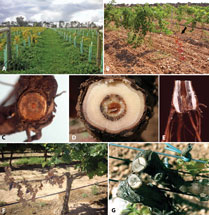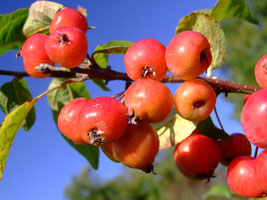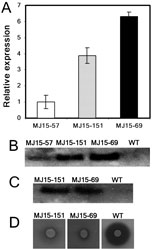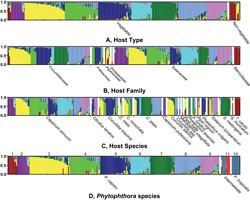| Plant Disease Feature Article | |
 In September's feature article entitled "Fungal Trunk Pathogens in the Grapevine Propagation Process: Potential Inoculum Sources, Detection, Identification and Management Strategies," Gramaje and Armengol discuss the increase in grapevine trunk pathogens since the early 1990s. The disease is caused by many different fungi and promoted by environmental and cultural practices. This feature illustrates the long term effects of relaxing quality control standards during rapid expansion of an industry. Read more... In September's feature article entitled "Fungal Trunk Pathogens in the Grapevine Propagation Process: Potential Inoculum Sources, Detection, Identification and Management Strategies," Gramaje and Armengol discuss the increase in grapevine trunk pathogens since the early 1990s. The disease is caused by many different fungi and promoted by environmental and cultural practices. This feature illustrates the long term effects of relaxing quality control standards during rapid expansion of an industry. Read more... |
| Editors' Picks | |
Plant Disease Editor's Pick
Dr. R. Michael Davis, Editor-in-Chief
 In the September issue of Plant Disease, D. R. Cooley and colleagues examine sources of variability among available models that forecast diseases of apple. Leaf wetness duration was highly variable, but canopy density, tree size, and cultivar, among other factors, also impacted the accuracy of the models. The study is applicable to many disease forecasting models as it illustrates the kind of detailed analysis that must be considered before any single model is universally applied to a crop. Read more... In the September issue of Plant Disease, D. R. Cooley and colleagues examine sources of variability among available models that forecast diseases of apple. Leaf wetness duration was highly variable, but canopy density, tree size, and cultivar, among other factors, also impacted the accuracy of the models. The study is applicable to many disease forecasting models as it illustrates the kind of detailed analysis that must be considered before any single model is universally applied to a crop. Read more...
MPMI Editor's Pick
Dr. Gary Stacey, Editor-in-Chief
 The plant cell wall represents an important barrier to pathogen infection. In the September issue of MPMI, Volpi et al. show that transgenic expression in wheat of an inhibitor of pectin methyl esterase leads to an increase in pectin methylation with a concomitant increase in fungal pathogen resistance. In this era of interest in plant cell wall chemistry for biofuel production, it is important to remember that cell wall modifications can have multiple effects. Read more... The plant cell wall represents an important barrier to pathogen infection. In the September issue of MPMI, Volpi et al. show that transgenic expression in wheat of an inhibitor of pectin methyl esterase leads to an increase in pectin methylation with a concomitant increase in fungal pathogen resistance. In this era of interest in plant cell wall chemistry for biofuel production, it is important to remember that cell wall modifications can have multiple effects. Read more...
Phytopathology Editor's Pick
Dr. Niklaus Grunwald, Editor-in-Chief
 The study by Quesada-Ocampo et al. is a nice reminder that plant pathogens continuously evolve and that populations are shaped by diverse evolutionary forces. Phytophthora capsici affects many solanaceous, cucurbitaceous, fabaceous, and other crops. This diversity in habitats is nicely reflected in the graphs resulting from the cluster analysis. P. capsici is evidently a diverse and recombining pathogen with a complex population structure. Read more... The study by Quesada-Ocampo et al. is a nice reminder that plant pathogens continuously evolve and that populations are shaped by diverse evolutionary forces. Phytophthora capsici affects many solanaceous, cucurbitaceous, fabaceous, and other crops. This diversity in habitats is nicely reflected in the graphs resulting from the cluster analysis. P. capsici is evidently a diverse and recombining pathogen with a complex population structure. Read more... |